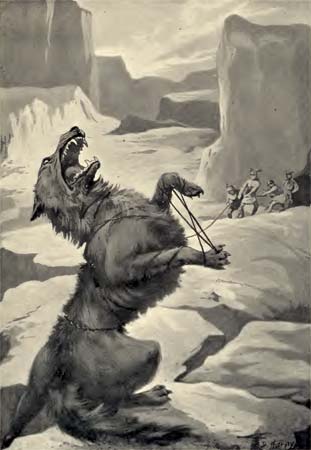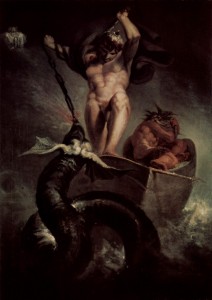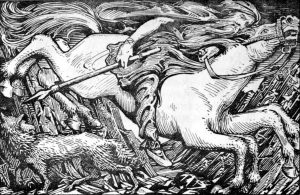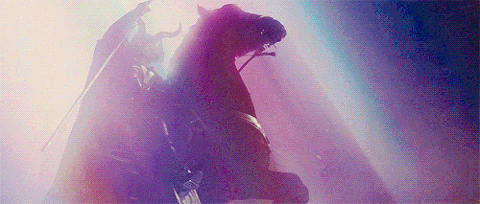From their earliest days, comic book heroes and characters have all had their origin stories, ones that make the reader keep flipping the pages, wanting to know more and more about how their favorite hero came to be and what information their backstory might hold to beating that enemy in the future.
While many heroes have their own backstory, sometimes there is even more backstory to the backstory. Backstory-ception? In any case and keeping in the spirit of this month’s theme, MYTHICAL, the Daily Crate is looking into the mythical and legendary beasts from the origins of Thor and Loki. We’re talking the creatures of Nordic Myths and Legends. Let’s get mythic!
Fenrir

The binding of Fenrir.
Dorothy Hardy/Myths of the Norsemen by H. A. Guerber
It’s not possible to kick off talking about Nordic mythical creatures with anyone besides Fenrir. Fenrir is possibly one of the most infamous wolves out there, especially in the eyes of Nordic Mythology. The first of Loki’s children that will be mentioned here, Fenrir was raised by the gods so they could keep him under control. As any mythical tale tends to go, control over a beast never bodes well for those trying to keep it.
The story of Fenrir goes as such, according to the Encyclopedia Britannica:
Fearing Fenrir’s strength and knowing that only evil could be expected of him, the gods bound him with a magical chain made of the sound of a cat’s footsteps, the beard of a woman, the breath of fish, and other occult elements.
Needless to say, that did not work. In this case, after breaking out of a magical chain, taking off a gods arm (sorry Tyr), and nearly devouring everything in his path during Ragnarok, Fenrir was finally killed by one of Odin’s sons.
That’s not to say that all of that drama did not gain the wolf notoriety. In pop culture today, comic book fans may be able to see Fenrir in the upcoming Thor: Ragnarok film (it is Ragnarok after all, it kind of fits in the with the myth perfectly) or can play the character of Fenrir in the game SMITE. Not bad for a mythical wolf, right?
Hugin and Munin
Great Odin’s Raven!
In actuality, there are two ravens, named Hugin and Muninn. According to Snorri Sturluson, a medieval Icelandic historian,
“Two ravens sit on his (Odin’s) shoulders and whisper all the news which they see and hear into his ear; they are called Huginn and Muninn. He sends them out in the morning to fly around the whole world, and by breakfast, they are back again. Thus, he finds out many new things and this is why he is called ‘raven-god’”
Depictions of Odin have been seen with at least one or more ravens, dating back to the 6th and 7th centuries AD. When looking at Nordic helmets or jewelry, it was not uncommon to see depictions of Odin and his ravens. Within the comic and film universes, the ravens can be seen in various issues of the Thor comics as well as accompanying Odin on the big screen for brief moments. They follow the same roles as their mythological counterparts, gathering information for Odin each day.
Jormungand

“Thor’s Battle with the Midgard Serpent” by Johann Heinrich Füssli (1788)
Known as the Great Beast or the Midgard Serpent, Jormungand is the snake or dragon that lives in the ocean that surrounds all of Midgard, otherwise known as Earth. We can thank Loki for the likes of the Midgard Serpent, as it is one of his children. In the scheme of myths and legends, there seems to always be a rival for such a monstrous beast. In this case, Jormungand’s specific rival is the mighty Thor, son of Odin. Why is that? Well, Nordic legend states that when Ragnarok arrives, the two are destined to kill one another. But what exactly is Ragnarok? Below is a snippet of how the general vibe of the event would seemingly be:
Brothers will fight
and kill each other,
sisters’ children
will defile kinship.
It is harsh in the world,
whoredom rife
—an axe age, a sword age—
shields are riven—
a wind age, a wolf age—
before the world goes headlong
No man will have
mercy on another.
Sounds like a lot of pressure on Thor!
Sleipnir

“Odin Rides to Hel” (1908) by W. G. Collingwood.
Have you ever seen an eight-legged horse? You can thank Loki for that one., though this time his child is not quite the menace.
Sleipnir, which means “The Sliding One” in Old Norse, was born when Loki shape-shifted into a mare and found himself enjoying the company of a giant’s stallion. Although the spawn of a trickster, Sleipnir is one of Odin’s spirits, a way of transportation for Odin as he rides to each of the Nine Worlds of Nordic myth. Viewers with a sharp eye would have noticed the godly steed in the Marvel Cinematic Universe with its appearance in the first Thor film.
Nidhogg
Within Nordic lore, there is the world-tree, Yggdrasil. All of the Nine Worlds (or realms) are held in its branches and the roots of the tree. Creatures of old call the roots their home, including Nidhogg, a serpent/dragon who is portrayed as eating at the roots of the tree. Why would a serpent or dragon want to do that? To bring the center of the Nordic cosmos into chaos!
Nidhogg actually appears in plenty of pop culture references, mostly within the video game world. A quick comparison of the Nordic serpent to the dragon Alduin within The Elder Scrolls V: Skyrim show they are both ideas of destruction, both feed on the souls of the dead, and both are through to bring the end of the world. Pop Culture never strays too far from the myths and legends of old!
Now that we have some of the heavy hitters out of the way, are there any mythical creatures, from any story, not just Nordic, that have caught your eye! Make sure to tell us in the comments or by using the hashtag #MythandLegendTDC



